Small Business: Resource Allocation, CRM, and Transnational Growth
VerifiedAdded on 2023/01/09
|5
|1658
|24
Report
AI Summary
This report examines key considerations for small businesses regarding resource allocation, customer relationship management (CRM), and transnational expansion. It discusses the importance of planning and allocating resources to achieve business objectives, including determining business scope, identifying resources, and evaluating human resources. The report also elaborates on the process of customer relationship management (CRM), emphasizing the need to maintain a positive relationship with customers and gather information about their preferences. Finally, it explores the reasons behind the transnational expansion of small enterprises, highlighting the advantages and disadvantages of operating in international markets, such as economies of scale, attracting new customers, and the need for increased capital and resources. The analysis provides insights into how small businesses can manage resources effectively, build strong customer relationships, and achieve sustainable growth through strategic expansion.
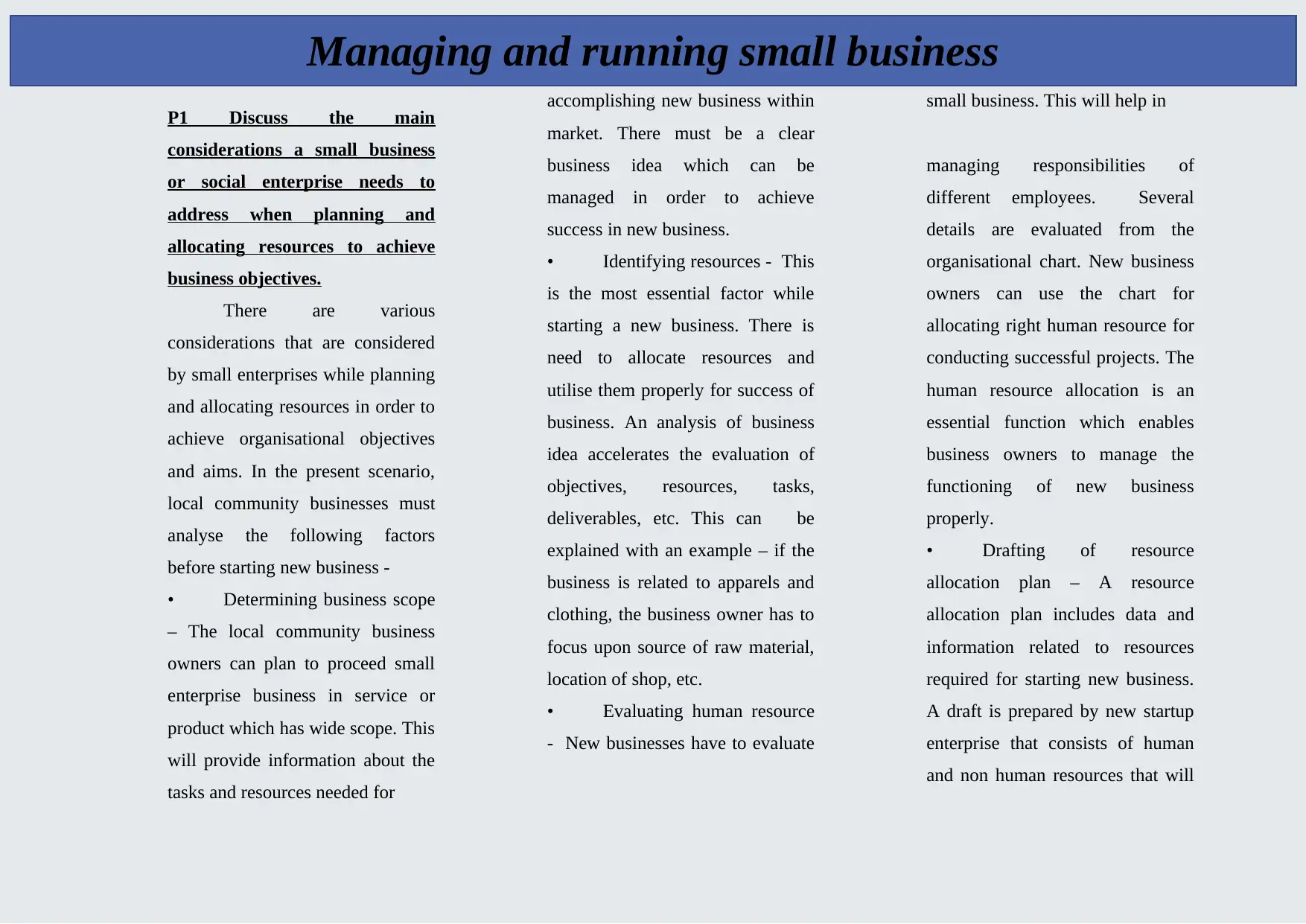
P1 Discuss the main
considerations a small business
or social enterprise needs to
address when planning and
allocating resources to achieve
business objectives.
There are various
considerations that are considered
by small enterprises while planning
and allocating resources in order to
achieve organisational objectives
and aims. In the present scenario,
local community businesses must
analyse the following factors
before starting new business -
• Determining business scope
– The local community business
owners can plan to proceed small
enterprise business in service or
product which has wide scope. This
will provide information about the
tasks and resources needed for
accomplishing new business within
market. There must be a clear
business idea which can be
managed in order to achieve
success in new business.
• Identifying resources - This
is the most essential factor while
starting a new business. There is
need to allocate resources and
utilise them properly for success of
business. An analysis of business
idea accelerates the evaluation of
objectives, resources, tasks,
deliverables, etc. This can be
explained with an example – if the
business is related to apparels and
clothing, the business owner has to
focus upon source of raw material,
location of shop, etc.
• Evaluating human resource
- New businesses have to evaluate
organisational chart for managing
small business. This will help in
managing responsibilities of
different employees. Several
details are evaluated from the
organisational chart. New business
owners can use the chart for
allocating right human resource for
conducting successful projects. The
human resource allocation is an
essential function which enables
business owners to manage the
functioning of new business
properly.
• Drafting of resource
allocation plan – A resource
allocation plan includes data and
information related to resources
required for starting new business.
A draft is prepared by new startup
enterprise that consists of human
and non human resources that will
Managing and running small business
considerations a small business
or social enterprise needs to
address when planning and
allocating resources to achieve
business objectives.
There are various
considerations that are considered
by small enterprises while planning
and allocating resources in order to
achieve organisational objectives
and aims. In the present scenario,
local community businesses must
analyse the following factors
before starting new business -
• Determining business scope
– The local community business
owners can plan to proceed small
enterprise business in service or
product which has wide scope. This
will provide information about the
tasks and resources needed for
accomplishing new business within
market. There must be a clear
business idea which can be
managed in order to achieve
success in new business.
• Identifying resources - This
is the most essential factor while
starting a new business. There is
need to allocate resources and
utilise them properly for success of
business. An analysis of business
idea accelerates the evaluation of
objectives, resources, tasks,
deliverables, etc. This can be
explained with an example – if the
business is related to apparels and
clothing, the business owner has to
focus upon source of raw material,
location of shop, etc.
• Evaluating human resource
- New businesses have to evaluate
organisational chart for managing
small business. This will help in
managing responsibilities of
different employees. Several
details are evaluated from the
organisational chart. New business
owners can use the chart for
allocating right human resource for
conducting successful projects. The
human resource allocation is an
essential function which enables
business owners to manage the
functioning of new business
properly.
• Drafting of resource
allocation plan – A resource
allocation plan includes data and
information related to resources
required for starting new business.
A draft is prepared by new startup
enterprise that consists of human
and non human resources that will
Managing and running small business
Paraphrase This Document
Need a fresh take? Get an instant paraphrase of this document with our AI Paraphraser
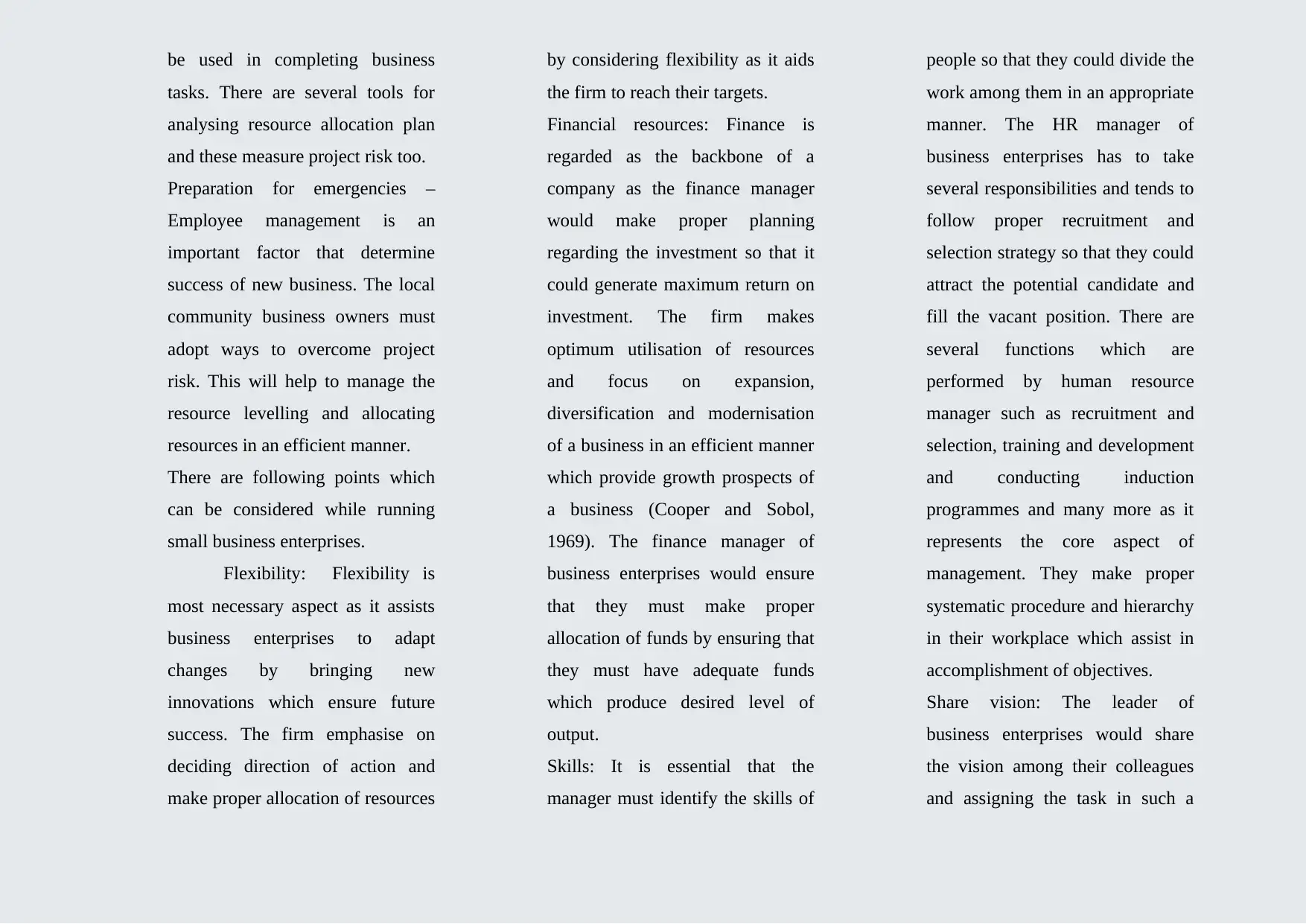
be used in completing business
tasks. There are several tools for
analysing resource allocation plan
and these measure project risk too.
Preparation for emergencies –
Employee management is an
important factor that determine
success of new business. The local
community business owners must
adopt ways to overcome project
risk. This will help to manage the
resource levelling and allocating
resources in an efficient manner.
There are following points which
can be considered while running
small business enterprises.
Flexibility: Flexibility is
most necessary aspect as it assists
business enterprises to adapt
changes by bringing new
innovations which ensure future
success. The firm emphasise on
deciding direction of action and
make proper allocation of resources
by considering flexibility as it aids
the firm to reach their targets.
Financial resources: Finance is
regarded as the backbone of a
company as the finance manager
would make proper planning
regarding the investment so that it
could generate maximum return on
investment. The firm makes
optimum utilisation of resources
and focus on expansion,
diversification and modernisation
of a business in an efficient manner
which provide growth prospects of
a business (Cooper and Sobol,
1969). The finance manager of
business enterprises would ensure
that they must make proper
allocation of funds by ensuring that
they must have adequate funds
which produce desired level of
output.
Skills: It is essential that the
manager must identify the skills of
people so that they could divide the
work among them in an appropriate
manner. The HR manager of
business enterprises has to take
several responsibilities and tends to
follow proper recruitment and
selection strategy so that they could
attract the potential candidate and
fill the vacant position. There are
several functions which are
performed by human resource
manager such as recruitment and
selection, training and development
and conducting induction
programmes and many more as it
represents the core aspect of
management. They make proper
systematic procedure and hierarchy
in their workplace which assist in
accomplishment of objectives.
Share vision: The leader of
business enterprises would share
the vision among their colleagues
and assigning the task in such a
tasks. There are several tools for
analysing resource allocation plan
and these measure project risk too.
Preparation for emergencies –
Employee management is an
important factor that determine
success of new business. The local
community business owners must
adopt ways to overcome project
risk. This will help to manage the
resource levelling and allocating
resources in an efficient manner.
There are following points which
can be considered while running
small business enterprises.
Flexibility: Flexibility is
most necessary aspect as it assists
business enterprises to adapt
changes by bringing new
innovations which ensure future
success. The firm emphasise on
deciding direction of action and
make proper allocation of resources
by considering flexibility as it aids
the firm to reach their targets.
Financial resources: Finance is
regarded as the backbone of a
company as the finance manager
would make proper planning
regarding the investment so that it
could generate maximum return on
investment. The firm makes
optimum utilisation of resources
and focus on expansion,
diversification and modernisation
of a business in an efficient manner
which provide growth prospects of
a business (Cooper and Sobol,
1969). The finance manager of
business enterprises would ensure
that they must make proper
allocation of funds by ensuring that
they must have adequate funds
which produce desired level of
output.
Skills: It is essential that the
manager must identify the skills of
people so that they could divide the
work among them in an appropriate
manner. The HR manager of
business enterprises has to take
several responsibilities and tends to
follow proper recruitment and
selection strategy so that they could
attract the potential candidate and
fill the vacant position. There are
several functions which are
performed by human resource
manager such as recruitment and
selection, training and development
and conducting induction
programmes and many more as it
represents the core aspect of
management. They make proper
systematic procedure and hierarchy
in their workplace which assist in
accomplishment of objectives.
Share vision: The leader of
business enterprises would share
the vision among their colleagues
and assigning the task in such a
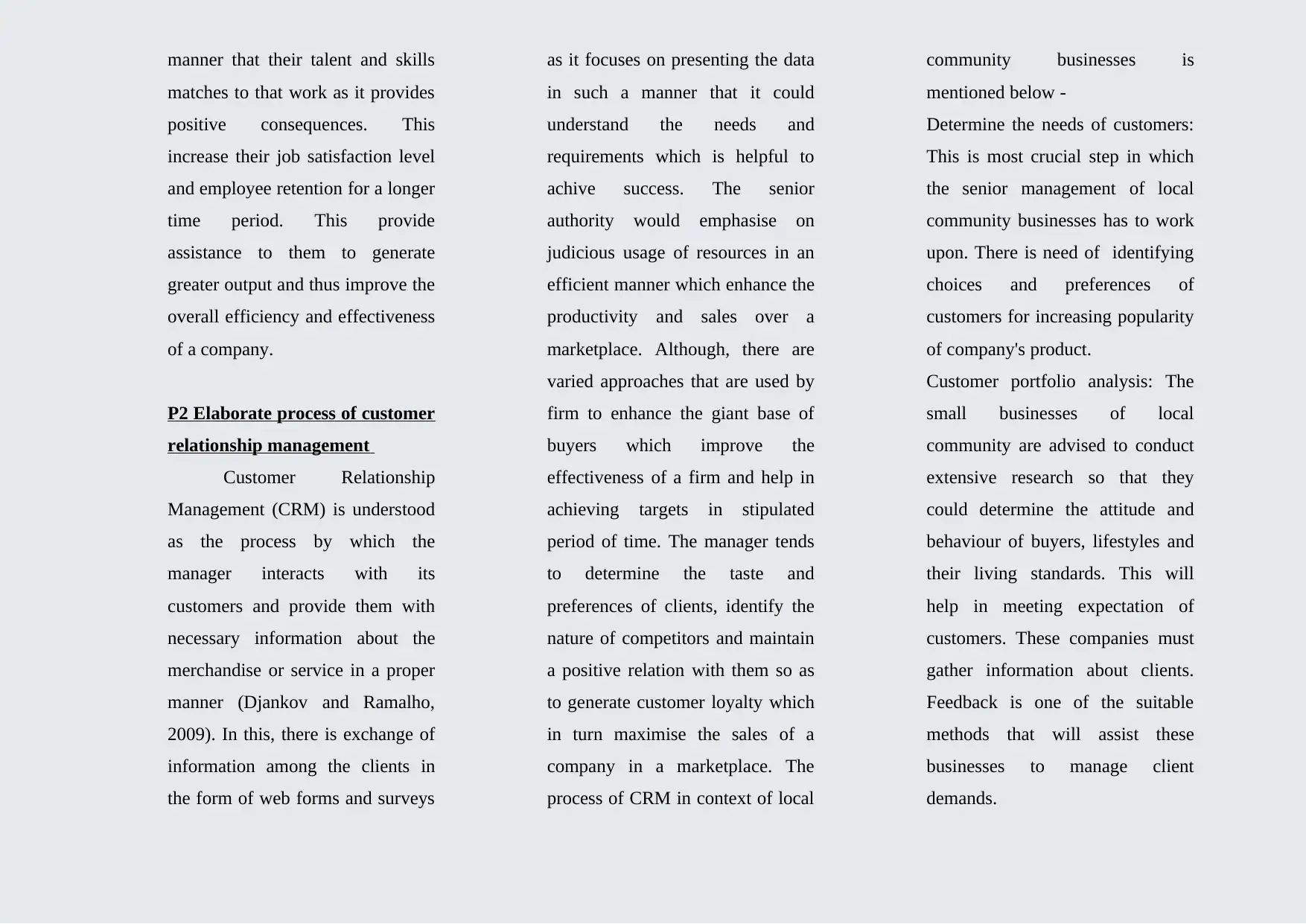
manner that their talent and skills
matches to that work as it provides
positive consequences. This
increase their job satisfaction level
and employee retention for a longer
time period. This provide
assistance to them to generate
greater output and thus improve the
overall efficiency and effectiveness
of a company.
P2 Elaborate process of customer
relationship management
Customer Relationship
Management (CRM) is understood
as the process by which the
manager interacts with its
customers and provide them with
necessary information about the
merchandise or service in a proper
manner (Djankov and Ramalho,
2009). In this, there is exchange of
information among the clients in
the form of web forms and surveys
as it focuses on presenting the data
in such a manner that it could
understand the needs and
requirements which is helpful to
achive success. The senior
authority would emphasise on
judicious usage of resources in an
efficient manner which enhance the
productivity and sales over a
marketplace. Although, there are
varied approaches that are used by
firm to enhance the giant base of
buyers which improve the
effectiveness of a firm and help in
achieving targets in stipulated
period of time. The manager tends
to determine the taste and
preferences of clients, identify the
nature of competitors and maintain
a positive relation with them so as
to generate customer loyalty which
in turn maximise the sales of a
company in a marketplace. The
process of CRM in context of local
community businesses is
mentioned below -
Determine the needs of customers:
This is most crucial step in which
the senior management of local
community businesses has to work
upon. There is need of identifying
choices and preferences of
customers for increasing popularity
of company's product.
Customer portfolio analysis: The
small businesses of local
community are advised to conduct
extensive research so that they
could determine the attitude and
behaviour of buyers, lifestyles and
their living standards. This will
help in meeting expectation of
customers. These companies must
gather information about clients.
Feedback is one of the suitable
methods that will assist these
businesses to manage client
demands.
matches to that work as it provides
positive consequences. This
increase their job satisfaction level
and employee retention for a longer
time period. This provide
assistance to them to generate
greater output and thus improve the
overall efficiency and effectiveness
of a company.
P2 Elaborate process of customer
relationship management
Customer Relationship
Management (CRM) is understood
as the process by which the
manager interacts with its
customers and provide them with
necessary information about the
merchandise or service in a proper
manner (Djankov and Ramalho,
2009). In this, there is exchange of
information among the clients in
the form of web forms and surveys
as it focuses on presenting the data
in such a manner that it could
understand the needs and
requirements which is helpful to
achive success. The senior
authority would emphasise on
judicious usage of resources in an
efficient manner which enhance the
productivity and sales over a
marketplace. Although, there are
varied approaches that are used by
firm to enhance the giant base of
buyers which improve the
effectiveness of a firm and help in
achieving targets in stipulated
period of time. The manager tends
to determine the taste and
preferences of clients, identify the
nature of competitors and maintain
a positive relation with them so as
to generate customer loyalty which
in turn maximise the sales of a
company in a marketplace. The
process of CRM in context of local
community businesses is
mentioned below -
Determine the needs of customers:
This is most crucial step in which
the senior management of local
community businesses has to work
upon. There is need of identifying
choices and preferences of
customers for increasing popularity
of company's product.
Customer portfolio analysis: The
small businesses of local
community are advised to conduct
extensive research so that they
could determine the attitude and
behaviour of buyers, lifestyles and
their living standards. This will
help in meeting expectation of
customers. These companies must
gather information about clients.
Feedback is one of the suitable
methods that will assist these
businesses to manage client
demands.
⊘ This is a preview!⊘
Do you want full access?
Subscribe today to unlock all pages.

Trusted by 1+ million students worldwide
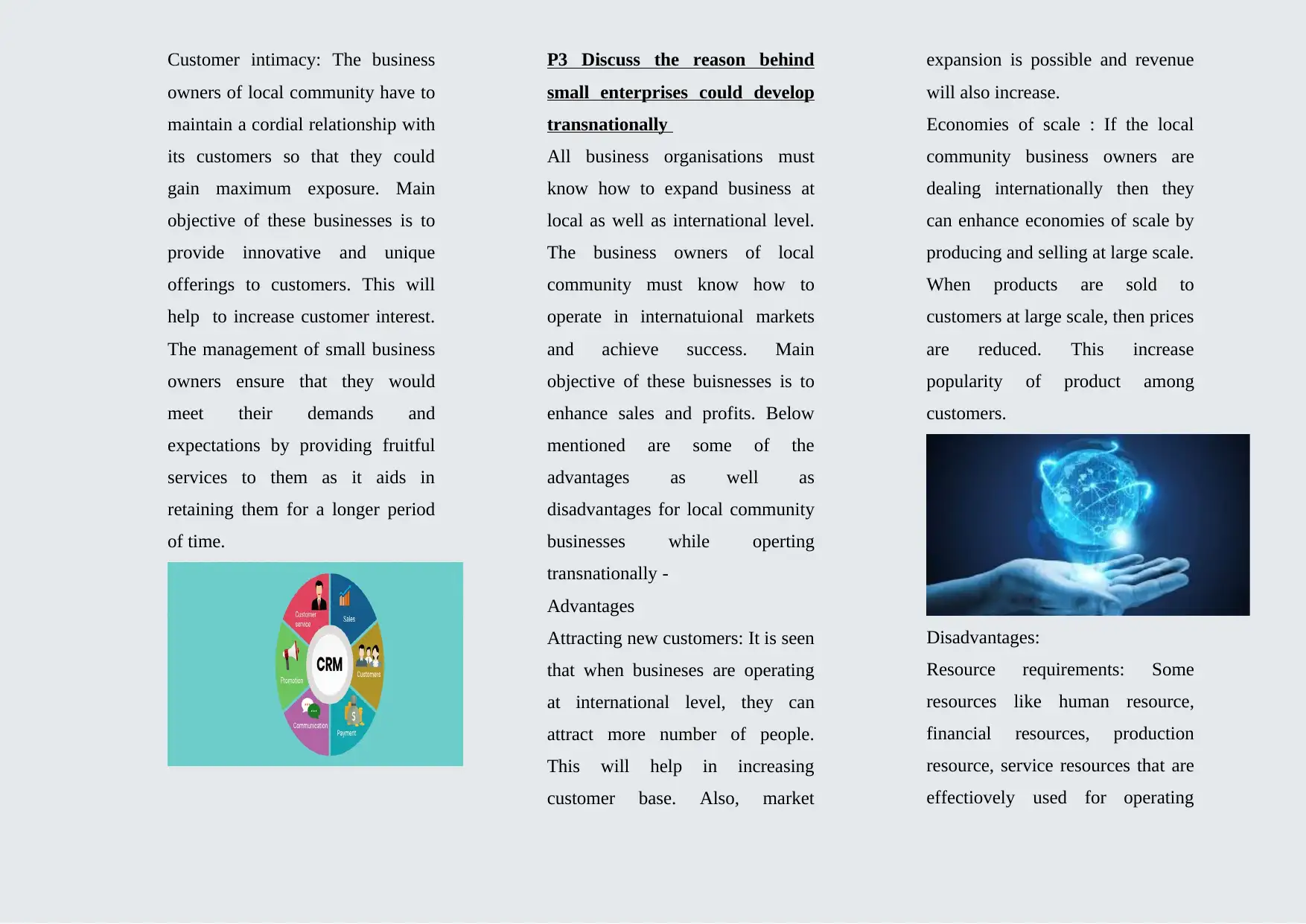
Customer intimacy: The business
owners of local community have to
maintain a cordial relationship with
its customers so that they could
gain maximum exposure. Main
objective of these businesses is to
provide innovative and unique
offerings to customers. This will
help to increase customer interest.
The management of small business
owners ensure that they would
meet their demands and
expectations by providing fruitful
services to them as it aids in
retaining them for a longer period
of time.
P3 Discuss the reason behind
small enterprises could develop
transnationally
All business organisations must
know how to expand business at
local as well as international level.
The business owners of local
community must know how to
operate in internatuional markets
and achieve success. Main
objective of these buisnesses is to
enhance sales and profits. Below
mentioned are some of the
advantages as well as
disadvantages for local community
businesses while operting
transnationally -
Advantages
Attracting new customers: It is seen
that when busineses are operating
at international level, they can
attract more number of people.
This will help in increasing
customer base. Also, market
expansion is possible and revenue
will also increase.
Economies of scale : If the local
community business owners are
dealing internationally then they
can enhance economies of scale by
producing and selling at large scale.
When products are sold to
customers at large scale, then prices
are reduced. This increase
popularity of product among
customers.
Disadvantages:
Resource requirements: Some
resources like human resource,
financial resources, production
resource, service resources that are
effectiovely used for operating
owners of local community have to
maintain a cordial relationship with
its customers so that they could
gain maximum exposure. Main
objective of these businesses is to
provide innovative and unique
offerings to customers. This will
help to increase customer interest.
The management of small business
owners ensure that they would
meet their demands and
expectations by providing fruitful
services to them as it aids in
retaining them for a longer period
of time.
P3 Discuss the reason behind
small enterprises could develop
transnationally
All business organisations must
know how to expand business at
local as well as international level.
The business owners of local
community must know how to
operate in internatuional markets
and achieve success. Main
objective of these buisnesses is to
enhance sales and profits. Below
mentioned are some of the
advantages as well as
disadvantages for local community
businesses while operting
transnationally -
Advantages
Attracting new customers: It is seen
that when busineses are operating
at international level, they can
attract more number of people.
This will help in increasing
customer base. Also, market
expansion is possible and revenue
will also increase.
Economies of scale : If the local
community business owners are
dealing internationally then they
can enhance economies of scale by
producing and selling at large scale.
When products are sold to
customers at large scale, then prices
are reduced. This increase
popularity of product among
customers.
Disadvantages:
Resource requirements: Some
resources like human resource,
financial resources, production
resource, service resources that are
effectiovely used for operating
Paraphrase This Document
Need a fresh take? Get an instant paraphrase of this document with our AI Paraphraser
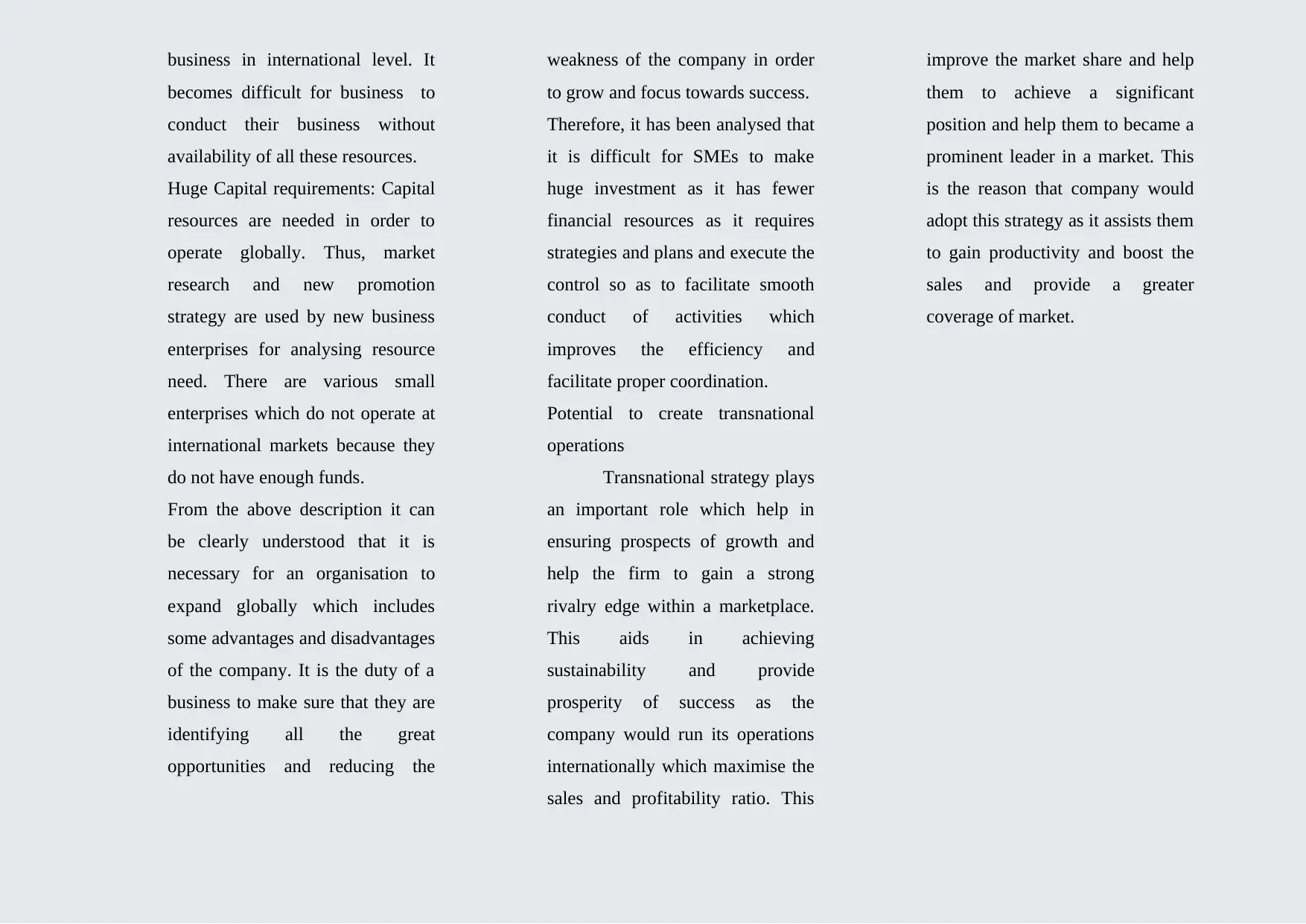
business in international level. It
becomes difficult for business to
conduct their business without
availability of all these resources.
Huge Capital requirements: Capital
resources are needed in order to
operate globally. Thus, market
research and new promotion
strategy are used by new business
enterprises for analysing resource
need. There are various small
enterprises which do not operate at
international markets because they
do not have enough funds.
From the above description it can
be clearly understood that it is
necessary for an organisation to
expand globally which includes
some advantages and disadvantages
of the company. It is the duty of a
business to make sure that they are
identifying all the great
opportunities and reducing the
weakness of the company in order
to grow and focus towards success.
Therefore, it has been analysed that
it is difficult for SMEs to make
huge investment as it has fewer
financial resources as it requires
strategies and plans and execute the
control so as to facilitate smooth
conduct of activities which
improves the efficiency and
facilitate proper coordination.
Potential to create transnational
operations
Transnational strategy plays
an important role which help in
ensuring prospects of growth and
help the firm to gain a strong
rivalry edge within a marketplace.
This aids in achieving
sustainability and provide
prosperity of success as the
company would run its operations
internationally which maximise the
sales and profitability ratio. This
improve the market share and help
them to achieve a significant
position and help them to became a
prominent leader in a market. This
is the reason that company would
adopt this strategy as it assists them
to gain productivity and boost the
sales and provide a greater
coverage of market.
becomes difficult for business to
conduct their business without
availability of all these resources.
Huge Capital requirements: Capital
resources are needed in order to
operate globally. Thus, market
research and new promotion
strategy are used by new business
enterprises for analysing resource
need. There are various small
enterprises which do not operate at
international markets because they
do not have enough funds.
From the above description it can
be clearly understood that it is
necessary for an organisation to
expand globally which includes
some advantages and disadvantages
of the company. It is the duty of a
business to make sure that they are
identifying all the great
opportunities and reducing the
weakness of the company in order
to grow and focus towards success.
Therefore, it has been analysed that
it is difficult for SMEs to make
huge investment as it has fewer
financial resources as it requires
strategies and plans and execute the
control so as to facilitate smooth
conduct of activities which
improves the efficiency and
facilitate proper coordination.
Potential to create transnational
operations
Transnational strategy plays
an important role which help in
ensuring prospects of growth and
help the firm to gain a strong
rivalry edge within a marketplace.
This aids in achieving
sustainability and provide
prosperity of success as the
company would run its operations
internationally which maximise the
sales and profitability ratio. This
improve the market share and help
them to achieve a significant
position and help them to became a
prominent leader in a market. This
is the reason that company would
adopt this strategy as it assists them
to gain productivity and boost the
sales and provide a greater
coverage of market.
1 out of 5
Related Documents
Your All-in-One AI-Powered Toolkit for Academic Success.
+13062052269
info@desklib.com
Available 24*7 on WhatsApp / Email
![[object Object]](/_next/static/media/star-bottom.7253800d.svg)
Unlock your academic potential
Copyright © 2020–2025 A2Z Services. All Rights Reserved. Developed and managed by ZUCOL.





